HARNESSES, the Good, the Bad and the Ugly……. K9C /PA News 31/1/2014
I ponder why people select a harness for their dog, when they are already pulling?? Historically, dogs were used for pulling and tracking so pulling is natural trait, in some breeds.
Imagine a bull –where is the strength? The obvious answer would be neck and fore-chest. So any harness fitted to bull, regardless of type, is always going to help with pulling.
Over my years of dog training, and especially when dealing with behavioural issues, I meet people who think a harness as equipment will make the dog more comfortable as there is normally no strain or pull on the neck – a part of the animal much better built to sustain guidance and direction, when using the right technique and equipment.
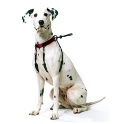 Harnesses generally go around the fore-chest and belly, very close to the shoulders and arm pits…… which is wherein the problem lies. This area has very delicate skin with quite some blood vessels and in the case of the dog often little or no hair to protect it.
Harnesses generally go around the fore-chest and belly, very close to the shoulders and arm pits…… which is wherein the problem lies. This area has very delicate skin with quite some blood vessels and in the case of the dog often little or no hair to protect it.
Ill-fitted harnesses – and that is more often the case than not – can do so much more damage and discomfort to the animal than any arrangement used around the neck. We see harnesses that go under the arm pits and even 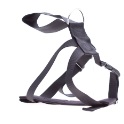 with a soft sock over the material; they are very uncomfortable for the dog. We see harnesses that have control points on the back, or the fore-chest or both. We see people walking their dog on a car harness with wide straps designed to clip a dog on the seat belt.
with a soft sock over the material; they are very uncomfortable for the dog. We see harnesses that have control points on the back, or the fore-chest or both. We see people walking their dog on a car harness with wide straps designed to clip a dog on the seat belt.
Most harnesses fit too closely to the arm pits – most are fitted too loosely and therefore rub, and some are too tight which can cause bruising.
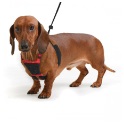 Some newer models are of a soft material, a little like an overall or tracksuit –soft and kind to the dog, but only suited to small dogs that pull… even then we question the benefits to stop pulling.
Some newer models are of a soft material, a little like an overall or tracksuit –soft and kind to the dog, but only suited to small dogs that pull… even then we question the benefits to stop pulling.
A great selection is available through the RSPCA shop. Certainly worth a look!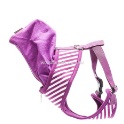
A good fitting harness uses the tightness of the belly / back strap to stop the harness from moving, but it should be at least 5 cm away from delicate armpits. If fitted properly at the chest the harness can be tightened as far back on the belly / back as possible. The dog is steered from the fore-chest without the harness moving on the dog’s body and shifting to under the arm pits. A well-fitted harness is where the belly strap and back strap form a VERTICAL line, and the chest strap a HORIZONTAL line, creating a letter ‘T’ on its side – see picture:
1. Make sure back/belly strap form ONE vertical STRAIGHT line…
2. Make sure that the Harness is allowed to sit as FAR back as possible, away from those delicate arm areas
 This is a near perfect harness fit using the Easy Walk Harness; the belly strap is well away from the dog’s delicate armpit areas and is ‘tight enough’ to not pull forwards, yet comfortable for Sunny.
This is a near perfect harness fit using the Easy Walk Harness; the belly strap is well away from the dog’s delicate armpit areas and is ‘tight enough’ to not pull forwards, yet comfortable for Sunny.
The horizontal strap is adjusted to sit nicely on his chest bone for comfort. It is loosened to make the vertical straps straight up and down. The leash is clipped on the chest strap at the front.
This Sporn Harness [R] is well away from the delicate areas and is comfortable for the dog to wear. However, horizontal strap is 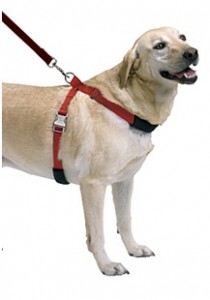 above the chest bone and therefore when the dog pulls it could choke. Note the padding and the velvet covers on the areas that matter!
above the chest bone and therefore when the dog pulls it could choke. Note the padding and the velvet covers on the areas that matter!
Some of the newer harnesses use a ‘Martingale’ style approach around the chest and belly to correct the dog from pulling.If fitted properly The Freedom No-pull harness is one of the more gentle available.
When looking for a harness, consider the following:
- The material with which it is made. Is there a Deluxe version or cover that makes it softer?
- How FAR does it sit back from the dog’s armpits and delicate areas?
- Where is it kept in place (tightness belly strap)
- Where are the control points and the choices you have (eg back, neck and/or chest)
- What size fits – again one size may look fine, but is ill-fitting. A snug fit is imperative
- What lead(s) are used to walk the dog (remember a dog at the end of a 1.80M leash pulls much more than a dog at heel with a short leash)
- What are the recommended models for my breed, dog size and age, and behaviour AND
- Is a harness the solution to the pulling??
For more information contact Hans van Heesbeen at the Australian Dog Trainers Academy at info@dogtrainersacademy.com.au
Australian Dog Trainers Academy is a proud member of Pets Australia and provides this information to the industry in good faith. Pets Australia does not warrant the information in this post. For all inquiries, contact the author using the details above.
BE A LEADER in the great Australian Pet Industry – JOIN PETS AUSTRALIA NOW!

